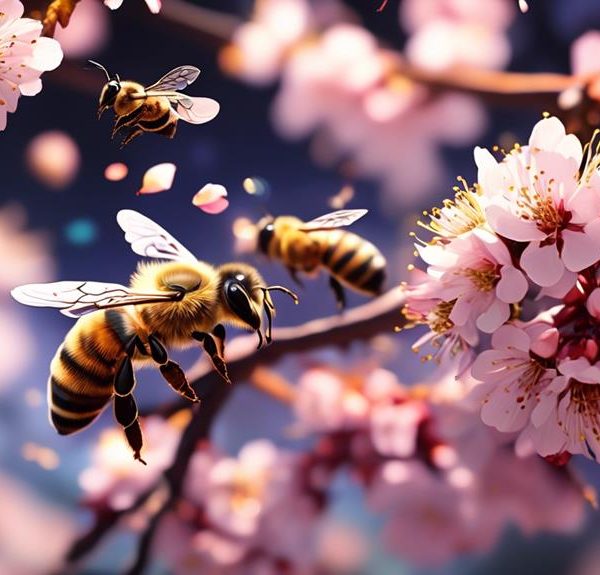Dive into the intriguing world of bee behavior to discover why these buzzing creatures may be frequenting your bird bath.
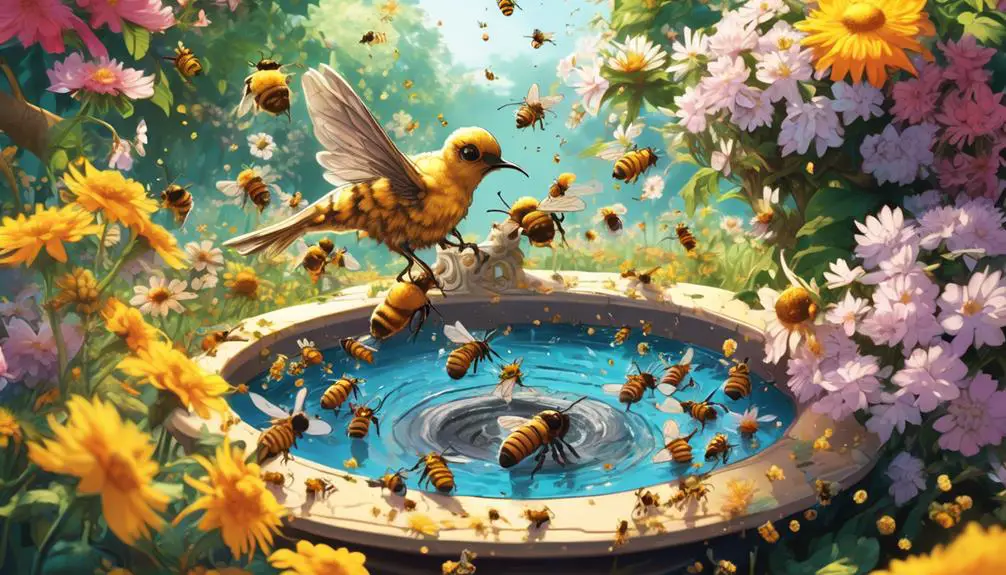
Do Bees Like Bird Baths
Sure, you might think that bees, those tiny winged workers of the insect world, would prefer a trendy, hipster microbrewery over a simple bird bath for their hydration needs. But, have you ever stopped to consider that bees could be frequenting your bird bath not just for a casual dip, but for essential survival?
Though it may not be their first drink of choice, water plays a crucial role in a bee's life. Unraveling the mystery of why and how bees use bird baths and other water sources could change the way you look at your backyard and its winged visitors.
So, are you ready to explore this seemingly small, yet immensely fascinating facet of bee behavior?
Key Takeaways
- Water is essential for bees' survival and hive health.
- Bird baths provide accessible and safer water sources for bees compared to traditional options like ponds or rivers.
- Making bird baths bee-friendly by adding rocks or twigs, maintaining shallow water depth, and placing them near flowers or gardens can attract bees.
- Bees face risks at bird baths such as drowning, predation, and exposure to harmful substances, but these risks can be mitigated by adding pebbles or stones and providing hiding spots.
Understanding Bee Hydration Needs
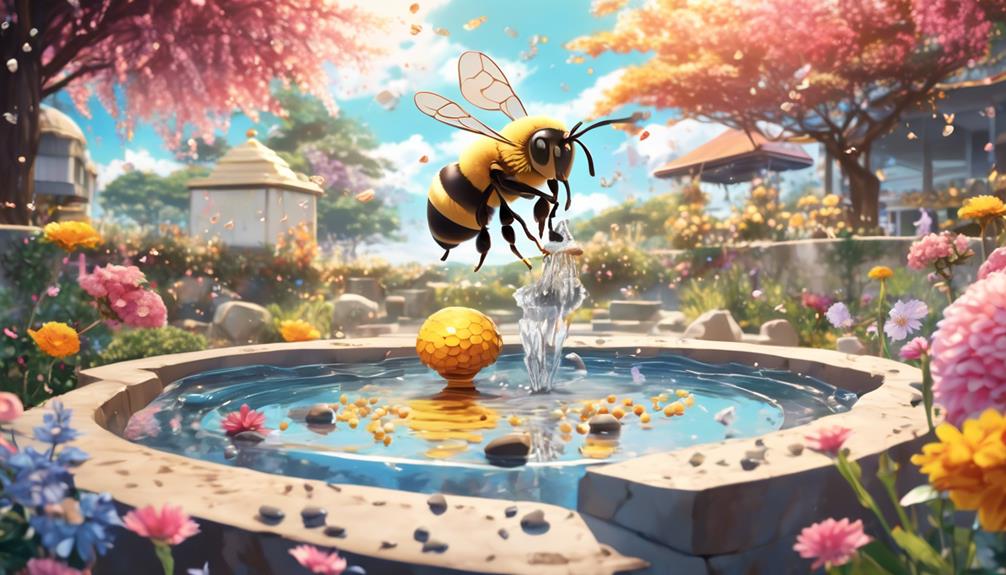
Understanding the hydration needs of bees involves delving into their unique biology and environmental requirements, which underscores their reliance on consistent water sources. You must appreciate that water isn't only a thirst quencher for these industrious insects. It's also a critical component in their hive's climate control system and is used to dilute honey for their larvae's consumption.
Consider the bee's anatomy first. Their short, straw-like proboscis limits their water source options. They can't scoop or suck up water like a dog or cat. They require shallow water sources where they can land and safely drink. That's where bird baths can be ideal, provided they're designed correctly.
The environmental aspect focuses on temperature control. On hot days, bees collect water, return to their hive, and distribute droplets around the entrance and brood cells. Then, they fan their wings to foster evaporation, effectively air conditioning the hive. Water's availability directly influences hive health and productivity.
Bees and Bird Baths: The Connection
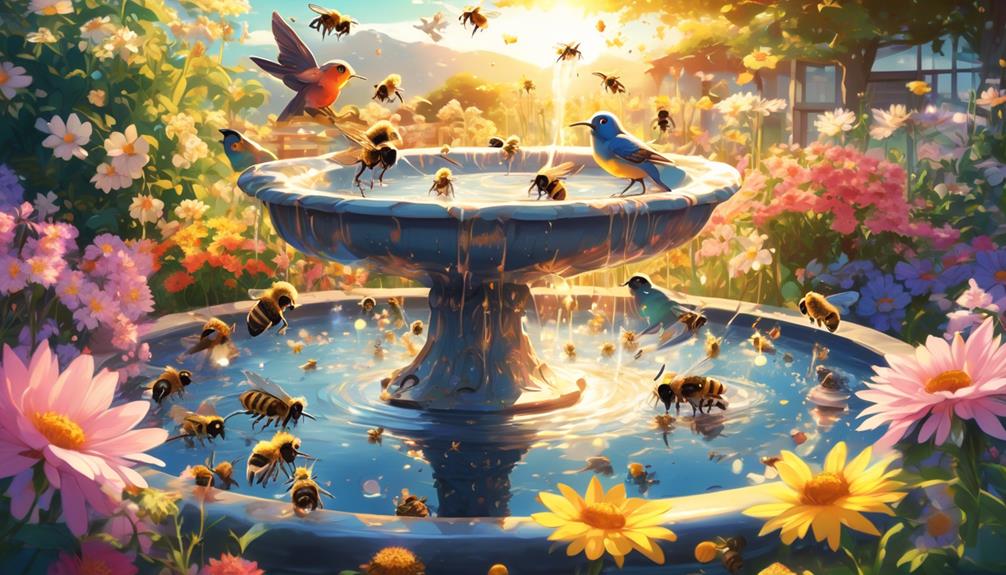
You might wonder how bird baths fit into the world of bees – these simple garden features can actually play a pivotal role in supporting bee populations by providing an accessible and shallow water source. Like birds, bees need water for survival, not just for hydration but also for regulating hive temperature and diluting stored honey. However, traditional water sources like ponds or rivers can pose a drowning risk due to their depths.
Bird baths, conversely, offer a safer option. They're shallow enough to prevent drowning, yet deep enough to provide sufficient water. The bees can land on the edge of the bird bath and drink without risk, especially if there are pebbles or sticks for them to land on.
Interestingly, bees prefer water that's been sitting for a while over fresh water. This is because stagnant water often contains essential minerals that bees need for their health. A bird bath left undisturbed can provide this. However, too much stagnation can promote harmful bacteria growth, so it's a delicate balance.
Making Your Bird Bath Bee-Friendly
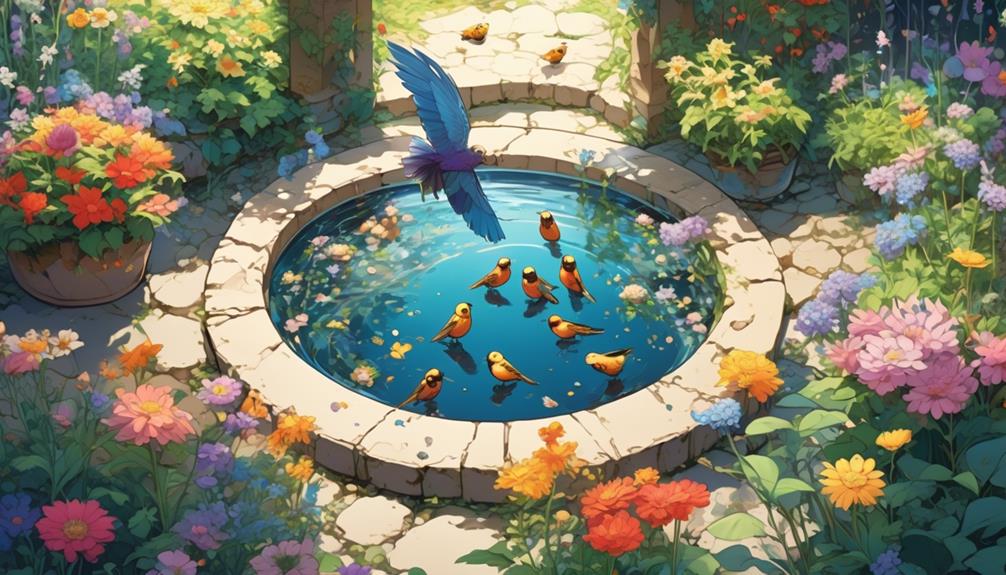
To ensure your bird bath is bee-friendly, frequently add small rocks or twigs, as these provide safe landing spots for bees to access the water without the risk of drowning. This strategy takes into account the bees' natural behavior and physical characteristics. Bees, unlike birds, can't float. Thus, they require a solid surface to land and drink.
Moreover, consider the depth of the water. It shouldn't be more than half an inch deep. Bees prefer shallow water sources and can easily drown in deeper ones. Therefore, maintaining a shallow depth is vital.
The location of your bird bath is also an essential factor. Place it near flowers or a garden to attract bees. However, ensure it's not directly under a bird feeder to avoid bird waste contaminating the water.
Lastly, cleanliness is key. Regularly cleaning your bird bath promotes a healthy environment for bees, preventing the growth of harmful algae or bacteria.
Risks Bees Face at Bird Baths
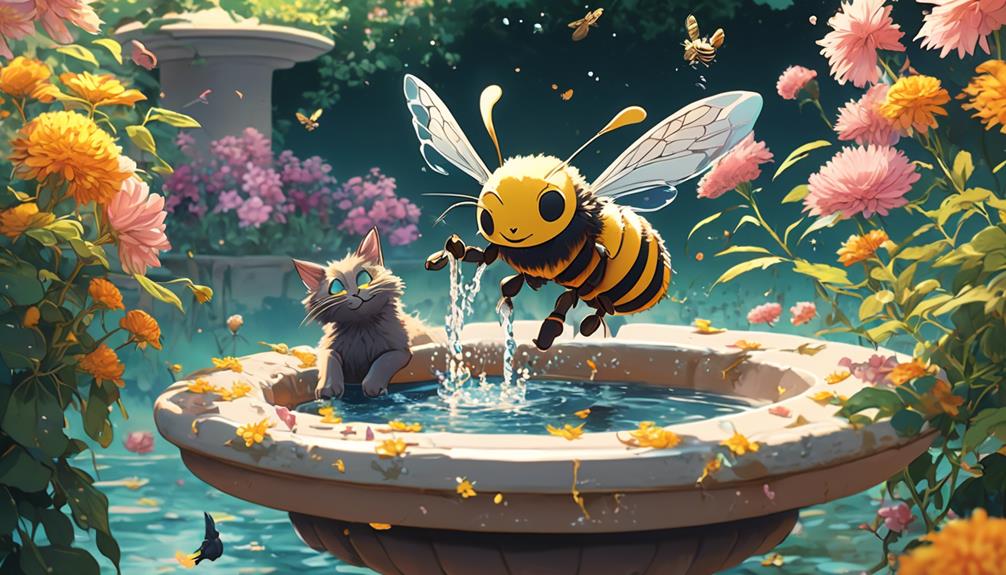
Despite their attraction to bird baths, bees encounter significant risks when seeking hydration from these sources. The most prevalent hazards include drowning, predation, and exposure to harmful substances.
Understanding these threats is vital for safeguarding these beneficial insects. Here's a detailed table summarizing the main risks:
Risk | Description | Mitigation |
|---|---|---|
Drowning | Bees can't swim and bird baths are often too deep | Add pebbles or stones for bees to land |
Predation | Birds, frogs, and other predators frequent bird baths | Provide hiding spots around the bird bath |
Harmful Substances | Bird baths can contain chemicals harmful to bees | Regularly clean the bird bath with natural substances |
Drowning is the most immediate and significant risk. Bird baths, unlike shallow puddles, are too deep for bees. When they land on the water to drink, they can easily become overwhelmed and drown.
Predation is another significant risk. Birds, frogs, and other wildlife that frequent bird baths can prey on bees.
Lastly, bird baths often contain harmful substances such as chlorine or soap residue, which can poison bees. Regular maintenance of bird baths is crucial to prevent this risk.
Promoting Bee Conservation in Your Garden
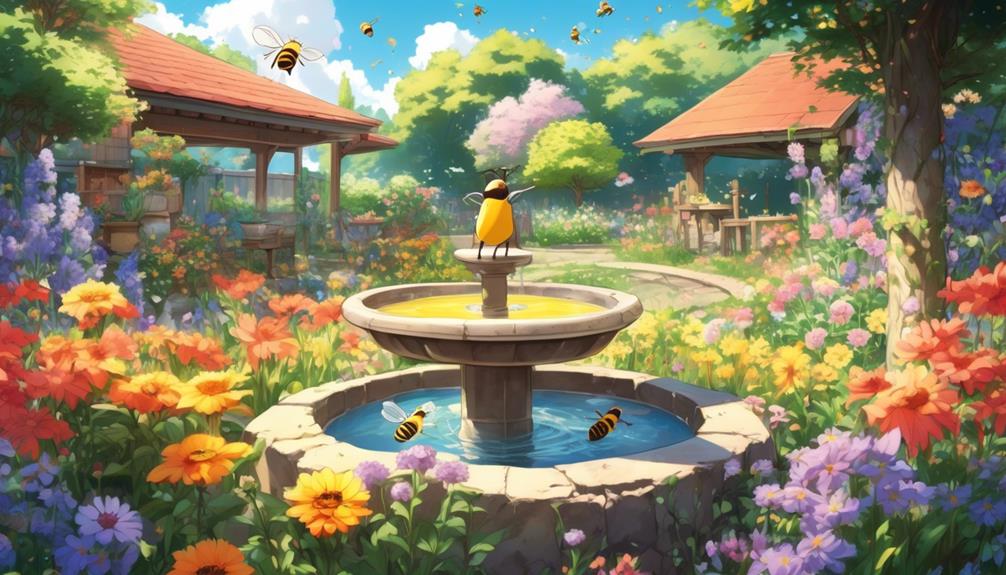
Understanding the risks bees face at bird baths is the first step, and this knowledge can be used to create a safer environment for them in your garden, promoting their conservation. It's essential to develop a garden that supports bee populations, contributing to their survival and improving your local ecosystem.
Firstly, consider providing bee-friendly plants. Bees are attracted to a variety of plants, including lavender, sunflowers, and rosemary. They're particularly drawn to native plants, so research local flora. You're not just creating a food source, but a habitat for bees.
Next, provide a safe water source. As we've noted, bird baths can present hazards to bees. Instead, offer shallow water sources with landing spots, like a dish filled with pebbles and water.
Finally, limit pesticide use. These chemicals are detrimental to bees, affecting their ability to reproduce and navigate. Opt for natural pest control methods.
Through these steps, you're not only creating a haven for bees but also promoting biodiversity in your garden. Remember, bees play an instrumental role in pollination, so their conservation is vital for maintaining the balance of our ecosystem.
Frequently Asked Questions
What Other Sources of Water Do Bees Prefer Aside From Bird Baths?"
Aside from bird baths, you'll find bees prefer other water sources. They're partial to dew and puddles, often gathering water from these in the early morning. They're also attracted to wet, damp areas like moist soil or sand.
Bees can even extract water from nectar or juicy fruits. They're not picky and will use any convenient water source. Remember, it's important to provide clean water in your garden for bees.
How Can We Maintain the Cleanliness of Bird Baths to Prevent Harming the Bees?"
To maintain cleanliness and prevent harm to bees, you'll need to regularly clean your bird bath. Scrub out any algae or debris, and rinse thoroughly.
Don't use harsh chemicals as they're harmful to bees. Instead, use a solution of one part vinegar to nine parts water.
Refill the bath with fresh water daily.
Additionally, include pebbles or stones to give bees a safe place to land and drink without drowning.
What Are the Specific Signs to Look for to Know if Bees Are Dehydrated?"
You'll notice dehydrated bees appearing weak or lethargic. They may be unable to fly and stay grounded, walking in circles. If it's hot and they're not taking off, it's a strong sign they need water.
Also, they might extend their proboscis, as if drinking air, which is another dehydration indicator. Be observant, these signs aren't always obvious.
Are There Any Specific Bird Bath Designs That Are More Attractive to Bees?"
Yes, there are specific bird bath designs that bees tend to prefer. You'll want to choose a shallow bird bath with a gentle slope.
Bees can't swim, so they need to be able to walk into the water. Adding stones or pebbles to the bird bath can also make it more attractive to bees, as it provides them with a place to land and drink.
Avoid using bird baths with steep sides or deep water.
What Kind of Plants Can I Grow in My Garden That Would Also Provide Hydration to Bees?"
You can grow plants like sunflowers, asters, and bee balms that not only attract bees but also retain water in their blooms or leaves.
Planting them in your garden provides bees with a dual benefit of food and hydration.
Additionally, you can create a bee waterer by placing pebbles in a shallow dish and filling it with water.
Bees can land on the pebbles and drink without the risk of drowning.
Conclusion
So, you see, bees do appreciate bird baths. They provide much-needed hydration, though certain risks pose a threat. By making simple modifications, your bird bath can become a safe haven for bees.
Remember, promoting bee conservation in your garden is a small but significant step towards preserving our ecosystem. After all, every drop of water in your bird bath counts in the greater scheme of bee survival.


